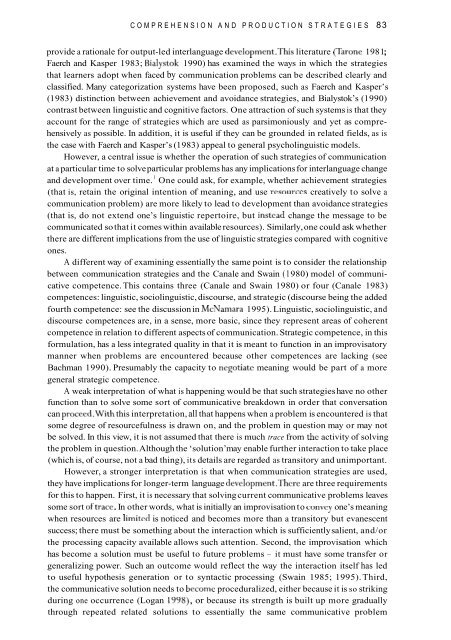English Language Teaching in its Social Context
English Language Teaching in its Social Context
English Language Teaching in its Social Context
Create successful ePaper yourself
Turn your PDF publications into a flip-book with our unique Google optimized e-Paper software.
COMPREHENSION AND PRODUCTION STRATEGIES 83provide a rationale for output-led <strong>in</strong>terlanguage development.This literature (Tarone 1981 ;Faerch and Kasper 1983; Bialystok 1990) has exam<strong>in</strong>ed the ways <strong>in</strong> which the strategiesthat learners adopt when faced by communication problems can be described clearly andclassified. Many categorization systems have been proposed, such as Faerch and Kasper’s(1983) dist<strong>in</strong>ction between achievement and avoidance strategies, and Bialystok’s (1990)contrast between l<strong>in</strong>guistic and cognitive factors. One attraction of such systems is that theyaccount for the range of strategies which are used as parsimoniously and yet as comprehensivelyas possible. In addition, it is useful if they can be grounded <strong>in</strong> related fields, as isthe case with Faerch and Kasper’s (1983) appeal to general psychol<strong>in</strong>guistic models.However, a central issue is whether the operation of such strategies of communicationat a particular time to solve particular problems has any implications for <strong>in</strong>terlanguage changeand development over time. ’ One could ask, for example, whether achievement strategies(that is, reta<strong>in</strong> the orig<strong>in</strong>al <strong>in</strong>tention of mean<strong>in</strong>g, and use resourccs creatively to solve acommunication problem) are more likely to lead to development than avoidance strategies(that is, do not extend one’s l<strong>in</strong>guistic repertoire, but <strong>in</strong>stcad change the message to becommunicated so that it comes with<strong>in</strong> available resources). Similarly, one could ask whetherthere are different implications from the use of l<strong>in</strong>guistic strategies compared with cognitiveones.A different way of exam<strong>in</strong><strong>in</strong>g essentially the same po<strong>in</strong>t is to consider the relationshipbetween communication strategies and the Canale and Swa<strong>in</strong> (1980) model of communicativecompetence. This conta<strong>in</strong>s three (Canale and Swa<strong>in</strong> 1980) or four (Canale 1983)competences: l<strong>in</strong>guistic, sociol<strong>in</strong>guistic, discourse, and strategic (discourse be<strong>in</strong>g the addedfourth competence: see the discussion <strong>in</strong> McNamara 1995). L<strong>in</strong>guistic, sociol<strong>in</strong>guistic, anddiscourse competences are, <strong>in</strong> a sense, more basic, s<strong>in</strong>ce they represent areas of coherentcompetence <strong>in</strong> relation to different aspects of communication. Strategic competence, <strong>in</strong> thisformulation, has a less <strong>in</strong>tegrated quality <strong>in</strong> that it is meant to function <strong>in</strong> an improvisatorymanner when problems are encountered because other competences are lack<strong>in</strong>g (seeBachman 1990). Presumably the capacity to negotiatc mean<strong>in</strong>g would be part of a moregeneral strategic competence.A weak <strong>in</strong>terpretation of what is happen<strong>in</strong>g would be that such strategies have no otherfunction than to solve some sort of communicative breakdown <strong>in</strong> order that conversationcan proceed.With this <strong>in</strong>terpretation, all that happens when a problem is encountered is thatsome degree of resourcefulness is drawn on, and the problem <strong>in</strong> question may or may notbe solved. In this view, it is not assumed that there is much trace from thc activity of solv<strong>in</strong>gthe problem <strong>in</strong> question. Although the ‘solution’ may enable further <strong>in</strong>teraction to take place(which is, of course, not a bad th<strong>in</strong>g), <strong>its</strong> details are regarded as transitory and unimportant.However, a stronger <strong>in</strong>terpretation is that when communication strategies are used,they have implications for longer-term language development.There are three requirementsfor this to happen. First, it is necessary that solv<strong>in</strong>g current communicative problems leavessome sort oftrace. In other words, what is <strong>in</strong>itially an improvisation to convcy one’s mean<strong>in</strong>gwhen resources are limited is noticed and becomes more than a transitory but evanescentsuccess; there must be someth<strong>in</strong>g about the <strong>in</strong>teraction which is sufficiently salient, and/orthe process<strong>in</strong>g capacity available allows such attention. Second, the improvisation whichhas become a solution must be useful to future problems ~ it must have some transfer orgeneraliz<strong>in</strong>g power. Such an outcome would reflect the way the <strong>in</strong>teraction <strong>its</strong>elf has ledto useful hypothesis generation or to syntactic process<strong>in</strong>g (Swa<strong>in</strong> 1985; 1995). Third,the communicative solution needs to becomc proceduralized, either because it is so strik<strong>in</strong>gdur<strong>in</strong>g one occurrence (Logan 1998), or because <strong>its</strong> strength is built up more graduallythrough repeated related solutions to essentially the same communicative problem












